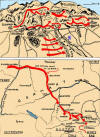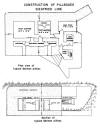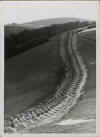|
Pillboxes |
| Photos of a typical pillbox and interior
shots including the air ventilation system - [S5, p 33] |
| Engineering drawing of the construction of a
pillbox - [S5, p 32] |
| "Pillboxes in general were 20 to
30 feet in width, 40 to 50 feet in depth, and 20 to 25 feet in height. At least
half of the pillbox was underground. The walls and roofs were 3 to 8 feet thick,
of concrete reinforced by wire mesh and small steel rods and at times by heavy
steel beams. Each pillbox had living quarters for its normal complement, usually
about seven men per firing embrasure. Few had more than two firing embrasures,
one specifically sited to cover the entrance. Although fields of fire were
limited, generally not exceeding an arc of 50 degrees, pillboxes were mutually
supporting." [S5, p 35] |
| Most pillboxes and bunkers had several
rooms, one or more for troop quarters and one or more either for
ammunition storage or for firing. [S5,
p 35] |
| All were gas proof and equipped with
hand-operated ventilation devices. Only a few installations had
escape hatches. [S5, p 35] |
| Heat might come from a small fireplace
equipped with a tin chimney, both of which might be closed off by a
heavy steel door. [S5, p 35] |
| Each entrance usually had a double set of
case-hardened steel doors separated by a gas proof vestibule. [S5, p 35] |
| Bunks were of the type found on troop ships,
oblong metal frames covered with rope netting and suspended in tiers
from the ceiling. [S5, p
35] |
| Sanitary facilities were rarely provided.
[S5, p 35] |
| Though both electric and telephone wires had
been installed underground, it is doubtful that these were
functioning well in September 1944. [S5,
p 35] |
| Some installations were camouflaged to
resemble houses and barns. [S5,
p 35] |
| Except in the sparse sector north of Geilenkirchen, pillbox density averaged
approximately ten per mile. [S5, p 35] |
| Most pillboxes were on forward slopes,
usually 200 to 400 yards behind the antitank obstacles. [S5, p 35] |
| |
| |













